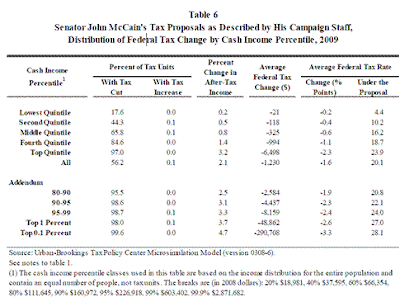So we are at a precipice – an awful 6.1% unemployment - #3 says more. Unfortunately, it’s truly a bad dataset that’s a recessionary signal of what’s to come, record debt & -30% weaker dollar notwithstanding. If it isn’t arrested by the next term end, it can turn depressionary. On the other end of matters, we have around $1 trillion deficit now. So far, McCain has identified $18 billion worth of earmarks to cut. 2 months to go & he’s yet to identify the rest. Obama’s numbers actually add up; a stark difference. That’ll be subject next time.
Don’t let the extreme yell-/bag-fest now get in the way of these [Three] Fundamental Facts
(pass it on or as response to any viral scare mails, particularly ones with un-sourced facts)
Here’s straight-up data of the record to inform and to make a case with facts and reasoning, not extremist emotions and fear, for moderate Democratic economic management. One informed by mainstream economics, not decades-old trickle-down dogma – dogma as there is no proof of its success yet to-date (e.g. that it even pays for itself, aka pay as you go).
 [#One], Democrats for the past 60 years have run the American economy better, and statistically significantly so. Professor Bartel of Princeton data from 1948 to 2007 demonstrates, which article and chart show. When Republicans occupied the White House for 34 years and Democrats for 26, average annual growth of real gross national product was 1.64 percent per capita under Republican presidents versus 2.78 percent under Democrats.
[#One], Democrats for the past 60 years have run the American economy better, and statistically significantly so. Professor Bartel of Princeton data from 1948 to 2007 demonstrates, which article and chart show. When Republicans occupied the White House for 34 years and Democrats for 26, average annual growth of real gross national product was 1.64 percent per capita under Republican presidents versus 2.78 percent under Democrats.
That 1.14-point difference, if maintained for eight years, would yield 9.33 percent more income per person, which is a lot more than almost anyone can expect from a tax cut.
[#Two], 95% of all American families get [even up to double] tax cuts w/ Obama’s plan. Below breaks it down for everyone. It’s sad to see McCain’s folks voting against their own economic interest, taking his word at face value when it’s a direct lie. Unless McCain’s supporters are just top 5% of income earners. But they’re about half the country. And you can see below that squarely half the country is actually just left out of McCain’s tax relief, getting less than a measly 1% tax cut.

 The obvious facts of the matter are McCain’s tax plan is way lop-sided versus Obama’s (this dataset and more can be found in the authoritative economic analysis that the respected bi-partisan Tax Policy Center did just mid-Aug. The last 4 columns of each respective table summarizes the full tax schedule for both candidates’ tax proposals, which the media tend to tease of course with bits & pieces as red meat to draw eyeballs and fatten up their ad buys). You can see for yourself below how Obama rebalances the tax code for everyone, especially folks that actually [need to] spend the money.
The obvious facts of the matter are McCain’s tax plan is way lop-sided versus Obama’s (this dataset and more can be found in the authoritative economic analysis that the respected bi-partisan Tax Policy Center did just mid-Aug. The last 4 columns of each respective table summarizes the full tax schedule for both candidates’ tax proposals, which the media tend to tease of course with bits & pieces as red meat to draw eyeballs and fatten up their ad buys). You can see for yourself below how Obama rebalances the tax code for everyone, especially folks that actually [need to] spend the money.
And even that doesn’t bring it back to pre-W/Clinton-era rates for the rich, when there was kick-ass growth. So don’t worry, the rich are still pretty rich. Just not dirty rich at the expense the rest of the country gets poorer. Consider that 75% of all income gains during the Bush Administration have gone to the top 1 percent of earners. Another decade perpetuating this kind of distorted rewarding of the pie, we’d have a real class revolt on our hands.
End of day, Obama’s plan is mainstream and prudent, though not a slogan-friendly, economic policy.
[#Three], now it’s 6.1% unemployment, up from 5.7%; economists were expecting 5.8%. 4/10 a point is a huge jump for this brief time period. It’s the highest rate since the jobless recovery of Sept 2003. Spiking so high so fast is a very nasty sign of what’s to come. What makes it an even graver dataset now is that behind the top number, for the first time in each and all categories that follow, it also affected:
- all races,
- all economic sectors (not just financial and construction),
- both college and non-college graduates (15% of college graduates could not find a job, another new high),
- % of workers part-time, at all time high resulting from record number with no full-time work,
- and is the 8th straight month of [big] job losses this year.
 Republicans are offering more ambiguous excuses, fairy tales (e.g. no macroeconomic numbers support as it doesn’t have any big positive economic impact other than record debt, so extremists hand wave w/ a lot of personal anecdotal stories), and try to share the blame even though Dems’ no power, and GOP’s no cohunes to own up to their 7 straight years of failures. They are the ones that want to continue the same ol’ tax cutting dogma of the last 7 years, debt-financed w/ love to China; now they own our $1.48 trillion tab to show for it.
Republicans are offering more ambiguous excuses, fairy tales (e.g. no macroeconomic numbers support as it doesn’t have any big positive economic impact other than record debt, so extremists hand wave w/ a lot of personal anecdotal stories), and try to share the blame even though Dems’ no power, and GOP’s no cohunes to own up to their 7 straight years of failures. They are the ones that want to continue the same ol’ tax cutting dogma of the last 7 years, debt-financed w/ love to China; now they own our $1.48 trillion tab to show for it.
We’ve two terms of way out of balance economic non-policies: debt-funded tax cuts for the top 1% to record spending we or our children don’t have anything to pay back with, in our or their lifetimes. Now with burst-bubbled credit markets and financial sector band-aid as dried up as worn out Arizona desert prunes, root problems are now coming to surface.
Enough.
http://www.msnbc.msn.com/id/26546938
Bleak jobs data keep economy at center stage - Jobless rate spikes to 6.1%, pressuring candidates to address economy
Job losses are expected to continue for the remainder of the year, according to Joel Prakken, chairman of Macroeconomic Advisers.
“We do view the economy as facing very significant challenges in the second half of the year,” he said, “particularly the consumer sector where house prices are still falling, equity prices are low, gasoline prices, while falling recently, are still high, and labor income, given these employment reports, is falling.”
So far this year, the economy has held up surprisingly well, given all the headwinds.
One reason may be the continued gains in productivity of American workers. The Labor Department reported Thursday that in the second quarter productivity rose at an annual rate of 4.3 percent.
But it’s not great news for American workers who are, in effect, working harder for the same wages. In fact, the report showed than unit labor costs fell a half-percent in the second quarter. The number of hours worked shrank by 0.8 percent, and wages, when adjusted for inflation, fell by 1.3 percent. That helps explain why, even as the economy has been able to post weak growth this year, American workers feel like they’re losing ground.
[Is America’s promise now really to expect more productive work and to expect and get less in return?]
